The northeastern state of Michigan is commonly known for its fishing, forests, and farming.
But perhaps the most notable achievements to come out of this Midwestern dreamland are in the form of the many state symbols it has adopted over the last several decades!
Rich historical and cultural moments derived from Michigan are all showcased in the many state symbols the Great Lake State has gathered, with the majority of these symbols being exclusive to the state!
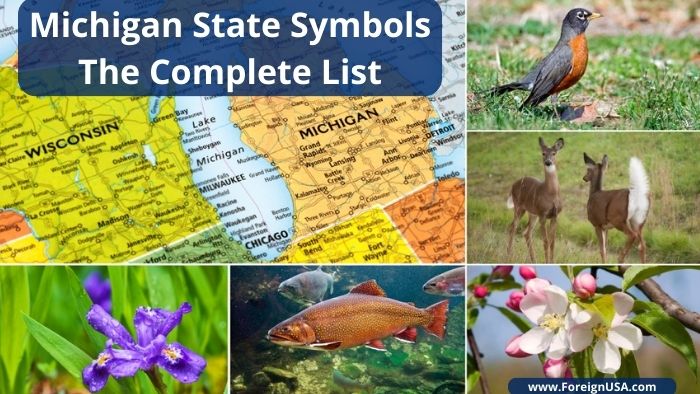
This guide will show you all of the state symbols associated with Michigan, as well as explain their significance in detail and interesting facts that you probably didn’t know about!
But first, let’s take a look at some quick Michigan facts and information:
- The name Michigan was derived from the Indian word “Michigama”, which means great or large lake.
- Michigan was granted statehood on January 26, 1837, becoming the 26th official U.S. state. Shortly after this, symbols began to be adopted by the state.
- Michigan’s official state nickname is the Wolverine State.
- Michigan has 21 official and non-official state symbols adopted over several decades.
State Symbols of Michigan Complete List
Below are all the state symbols of the great state of Michigan.
Additionally, at the bottom of this page is a table featuring these symbols as well as the dates they were adopted.
If you are a Michigander, you may remember learning about some of these during your school years, so for now, here is a refresher of the complete list.
Michigan State Bird
The Michigan state bird is the red-breasted robin and was adopted as an official symbol in 1931, after a successful election held by the Michigan Audubon Society.
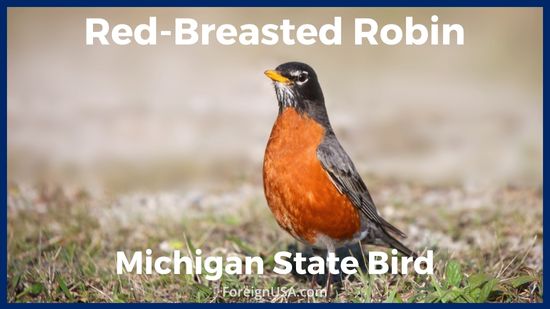
The legislation agreed that the most well-known and “best-loved” bird residing in the state of Michigan was indeed the red-breasted robin or American robin (Turdus migratorius) as many know it to be. It is also the official state bird of both Connecticut and Wisconsin.
Michigan State Capital
The state capital of Michigan is the city of Lansing and has been since 1847. Lansing is situated in the southern peninsula of Michigan state, where the Grand and Red Cedar Rivers meet.

Despite being named the capital of Michigan in 1847, it was not considered an official city. However, this changed over 10 years later, when in 1859, Lansing was finally incorporated into a city. There is a lot of state history stored in the state capitol building, which you can read about on the official Michigan capitol website.
Michigan State Coat of Arms
The official Michigan coat of arms features a moose and an elk on either side of an eagle, with the well-known Michigan state motto featured underneath – keep reading to find out more about the state motto of Michigan.
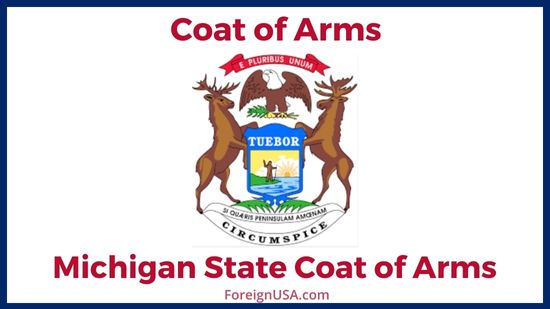
Michigan’s coat of arms appears on the state seal and the state flag. It was created and adopted on June 2, 1835.
Michigan State Fish
Michigan adopted the brook trout as the official state fish back in 1988 – due to Michigan being known for its abundance of lakes and rivers, this probably does not come as a surprise. Brook Trout can only reside in waters that are clean, clear, and cool in temperature.

This was not the first Michigan state fish, however. Michigan initially adopted “the trout” as the state fish in 1965, but there are four trout subspecies. So, to make things more specific, they went with the brook trout instead of brown trout, rainbow trout, or lake trout.
Michigan State Flag
The Michigan state flag became official in 1911 after being adopted by the state Legislature – the description reads: The State Flag shall be blue charged with the arms of the State.

As you can see – the flag features the state arms and the state motto on a Michigan blue background. With the state flag adoption came a pledge. The Michigan state flag pledge is as follows:
“I pledge allegiance to the flag of Michigan,
and to the state for which it stands,
Two beautiful peninsulas united by a bridge of steel,
where equal opportunity and justice to all is our ideal.”
Michigan State Flower
The apple blossom has been the official Michigan state flower since its adoption way back in 1897. These beautiful flowers are abundant across the state and sport a beautiful white and pink color combination.
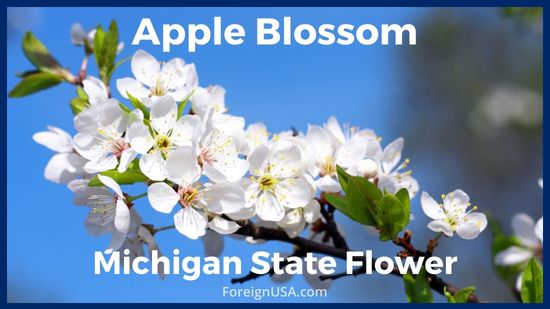
Officially adopted by the state legislation, the excerpt from the state legislature reads: “Our blossoming apple trees add much to the beauty of our landscape, and Michigan apples have gained a worldwide reputation. At least one of the most fragrant and beautiful species of apple, the Pyrus Coronaria, is native to our state.” Michigan has been one of the leading producers of apples and apple products since those early days.
Michigan State Fossil
Michigan’s official state fossil is the giant mastodon (Mammut americanum) after being adopted in 2002. These incredible animals are often mistaken for mammoths, which makes sense considering their appearance. However, mastodons were smaller and stockier than mammoths and were also wood browsers.
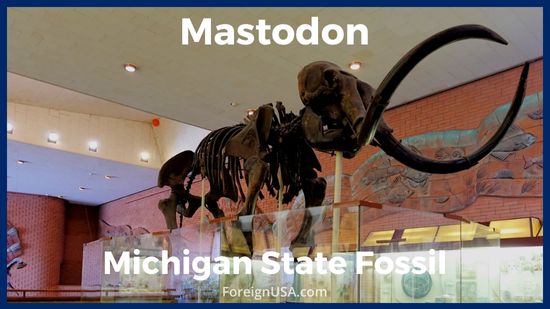
Unfortunately, these incredible animals disappeared from North America over 10,000 years ago. One of the most complete skeletons was discovered in Michigan and displayed at Michigan’s Museum of Natural History.
Michigan State Game Animal
Unlike most other states, Michigan does not have a state animal; instead, it has a state game animal, the white-tailed deer. The white-tailed deer was adopted as the official game animal to represent Michigan in 1997 after some fourth graders in the town of Zeeland campaigned to feature the deer as one of the state symbols.

White-tailed deer can be found across the state, living amongst Michigan’s glorious luscious wildlife. They are incredibly impressive animals, reaching speeds of up to 40 miles per hour, and they can also jump 9 feet in the air and swim at 13 miles per hour!
The white tail is used to signal danger when running, almost resembling flashing. In the early days, Native Americans banked on these deer for buckskin and food.
Michigan State Gem
Isle Royale Greenstone (chlorastrolite) has been the official state gem of Michigan since 1973 – they are beautiful green stones with many different and unique colorations, along with the main colors of blue and green. This greenstone is a variation of the pumpellyite mineral.

The Isle Royale greenstone can be found across the state of Michigan, and they also go by the names of “green starstone” or “turtleback.” They are tiny stones that are almost bean-shaped and similar in size too. Collecting this greenstone from Isle Royale National Park in Michigan is prohibited.
Michigan State Historical Society
It was only in 2002 that the Historical Society of Michigan became an official state symbol representing the state, despite being established back in 1828! Initially, the historical society was formed to foster the application and understanding of the state’s rich history and encourage preserving said rich history.

Their mission as a historical society was to develop quality historical publications of Michigan history, which included the Historic Michigan Travel Guide and the Michigan History Directory. Additionally, they wanted to encourage funding and support for historical education within the state and organize a Michigan History day and educator conferences.
Michigan State Motto and Nickname
The Michigan state motto is a famous Latin quote that reads, “Si quaeris peninsulam amoenam, circumspice,” which translates to “If you seek a pleasant peninsula, look about you.” This quote perfectly sums up the beautiful and natural land of the state. You can also see this famous motto featured on the Coat of Arms and State Seal.

Michigan does not only have a state motto, but it also has an official nickname that has been used to represent the state and a few unofficial nicknames. The official nickname of Michigan is the “Great Lakes State”.
This nickname was adopted on January 26, 1837, just after the state was officially admitted to the union, becoming the 26th official U.S. state. Many people past and present have associated Michigan with its impressive and infamous Great Lakes system.
These are a series of large freshwater lakes that are connected to the Atlantic Ocean. Michigan’s great lakes appear on the U.S. Quarter, along with the nickname. You can find out more information regarding the Michigan nickname with our dedicated guide.

Michigan State Reptile
The painted turtle has been the official Michigan state reptile since 1995, when a group of fifth-graders from Niles, MI, rallied for an official state reptile to represent their state. Painted turtles are somewhat unusual-looking, sporting yellow and red markings across their face, heads, and bodies, which is where they get their name from.

They typically reside in shallow waters and feed off vegetation, insects, crayfish, mollusks, and anything else they can fit in their mouths! They range in size, growing up to anywhere between 4 to 10 inches (10 cm to 25 cm) in length. Painted turtles usually hibernate during winter, finding soft mud to dig into and begin hibernation.
Michigan State Soil
Michigan’s official state soil is the Kalkaska soil series and has been since its adoption in 1990. This soil resides in the state’s upper and lower peninsulas, utilized primarily for sugar maple and birch hardwood timbers.

Occasionally, it will be used for the growth of Christmas trees and other specialty crops like strawberries and potatoes. Kalkaska soil was initially created in the sandy deposits left by the glaciers that once inhabited Michigan.
Michigan State Song
It would only be right for the state song of Michigan to be “My Michigan.” The original lyrics to the song were written back in 1862 by a native of Detroit during the Civil War. However, it wasn’t until 1936 that Michigan officially adopted the song as the official state song of Michigan.

The song has been embedded into Michigan’s history for some time now, and you can read or listen to the lyrics here.
Michigan State Stone
The official Michigan state stone is the Petoskey stone, which is actually not a stone at all – rather, it is a fossilized coral. Petoskey stone became the Michigan state stone symbol in 1965, and it pays homage to the shallow seas that surrounded the state some 350 million years ago, brimming with life and coral colonies.

These corals/stones are unique-looking and beautiful and can be found all across the Lake Michigan beaches.
Michigan State Tree
The old and wise eastern white pine tree has been the official Michigan state tree since 1955, when it was initially adopted to represent the state’s rich background in logging, with the logging industry playing an incredibly significant role in the stable economy of Michigan today.

White pines (Pinus strobus) have been a main part of Michigan’s lumber industry since the early pioneer days, dating from the 1860s to the 1890s. During these years, Michigan led the entire nation in lumber production!
Michigan State Wildflower
The gorgeous and now endangered dwarf lake iris (Iris lacustris) has been the official Michigan state wildflower since 1998. What makes them so unique, apart from their appearance, is that they can only be found residing across the coastlines of northern Lake Michigan, eastern Lake Huron, the southern shores of Lake Superior, and just a handful of the islands of the Great Lakes.

These are some of the smallest in the iris family, typically growing to 6 to 8 inches (15.25 to 20.3 cm) in height and between 1.5 to 2 inches (3.8 to 5.1 cm) in length. They will only bloom for one week per year, which occurs during the months of May through to early July. As you can see, their coloration is always purple, with the occasional white mutation.
Michigan State Seal
The official seal of Michigan features the state’s coat of arms, which also appears on both sides of the state flag. The state seal was officially adopted on June 2, 1835, 2 years before Michigan became an official state. The Michigan.gov website has stated that “Michigan’s Coat of Arms was inspired by the 17th Century coat of arms of the Hudson’s Bay Company, one of the earliest and largest fur-trading companies in North America.”
Here is a downloadable version of Michigan’s state seal:
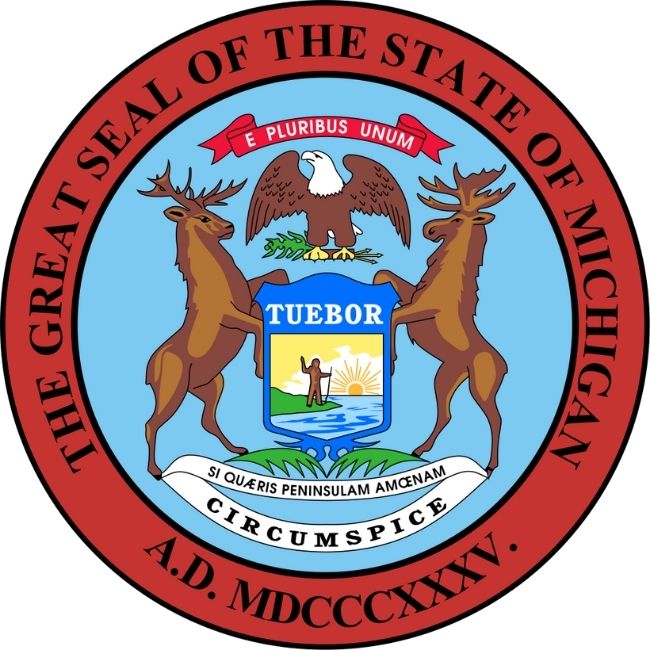
Additionally, the Moose and Elk represent Michigan as they are both native to the state, and the Bald Eagle is featured to represent the United States. There are also some Latin phrases that appear on the state seal: “Si Quaeris Peninsulam Amoenam, Circumspice” is Michigan’s state motto that means “If you seek a pleasant peninsula, look about you”. “E Pluribus Unum”, which means “From Many, One” or “One From Many” – our nation is made from many states.
Michigan State Children’s Book
In 1998, Michigan adopted a brand new state symbol in the form of a state Children’s Book, “The Legend of the Sleeping Bear”, written by Kathy-jo Wargin and illustrated by Gijsbert van Frankenhuyzen.

The narrative of the book is that of a mother’s everlasting devotion to her young, based on the native American legend – the creation of the Dunes and Islands, located at the Sleeping Bear Dunes National Lakeshore.
Michigan State Symbols Table
Below we have created a table of all the Michigan state symbols, including the dates on which they were adopted, and links to individual pages, covering the individual symbols in more depth and detail.
| Type of Symbol | Michigan Symbol | Year of Adoption |
|---|---|---|
| Michigan State Coat of Arms | Coat of Arms of the State of Michigan | 1835 |
| Michigan State Motto | Si quaeris peninsulam amoenam circumspice | 1835 |
| Michigan State Seal | Great Seal of the State of Michigan | 1835 |
| Michigan State Nickname | Great Lakes State | 1837 |
| Michigan State Capital | Lansing | 1847 |
| Michigan State Flower | Apple Blossom (Malus sp.) | 1897 |
| Michigan State Flag | Flag of the State of Michigan | 1911 |
| Michigan State Bird | American robin (Turdus migratorius) | 1931 |
| Michigan State Song | "My Michigan" | 1937 |
| Michigan State Tree | Eastern White Pine (Pinus strobus) | 1955 |
| Michigan State Stone | Petoskey Stone (Hexagonaria pericarnata) | 1965 |
| Michigan State Gem | Isle Royale greenstone (Chlorastrolite) | 1972 |
| Michigan State Fish | Brook Trout | 1988 |
| Michigan State Soil | Kalkaska soil series | 1990 |
| Michigan State Reptile | Painted turtle (Chrysemys picta) | 1995 |
| Michigan State Game Mammal | White-Tailed Deer (Odocoileus virginianus) | 1997 |
| Michigan State Children's Book | The Legend of the Sleeping Bear | 1998 |
| Michigan State Wildflower | Dwarf Lake Iris (Iris lacustris) | 1998 |
| Michigan State Fossil | Mastodon (Mammut americanum) | 2002 |


